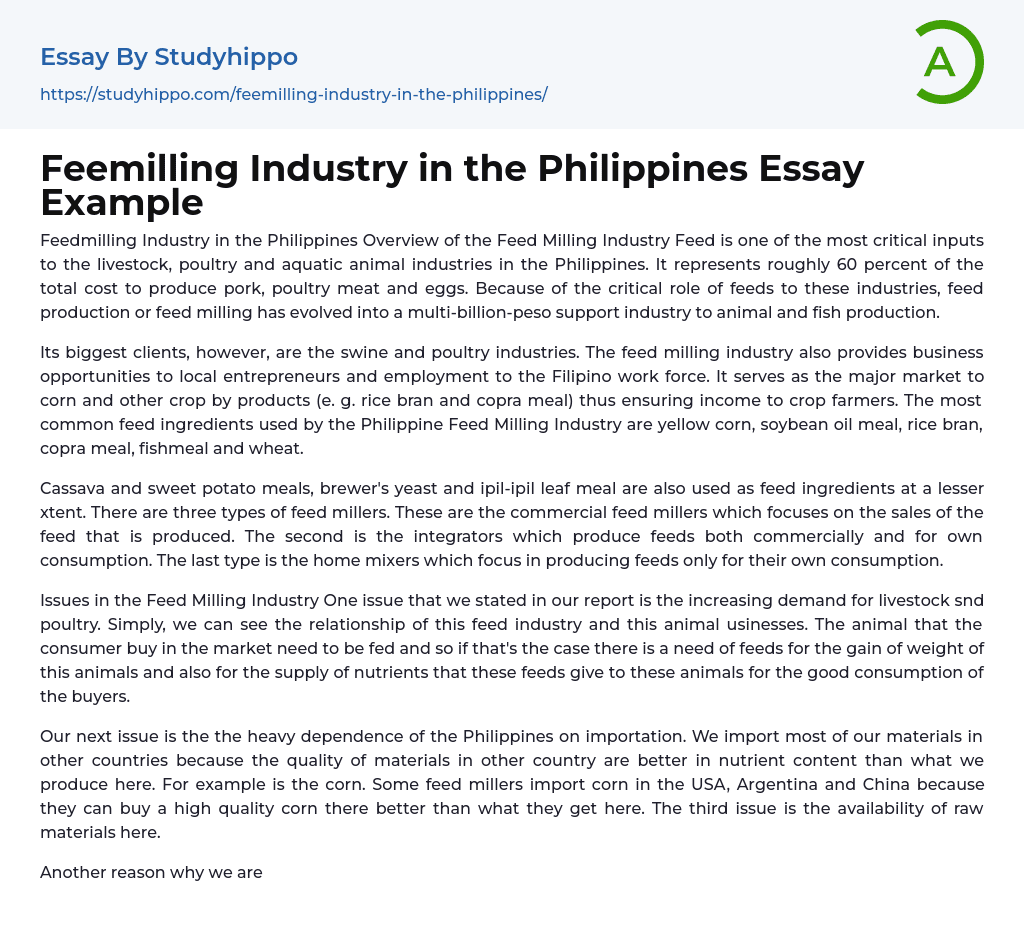The feed milling industry in the Philippines is vital for supporting the livestock, poultry, and aquatic animal sectors. It produces feeds that make up around 60 percent of the total cost of pork, poultry meat, and egg production. This has made the feed milling industry a multi-billion-peso industry that plays a critical role in supporting animal and fish production.
Its primary customers are the swine and poultry industries, while also offering business opportunities to local entrepreneurs and employment to Filipino workers. The feed milling industry acts as a crucial market for corn and other crop by-products, such as rice bran and copra meal, which guarantees income for crop farmers. The Philippine Feed Milling Industry commonly utilizes ingredients like yellow corn, soybean oil meal, rice bran, copra meal, fishmeal, and wheat.
Cassava, sweet potato meals, brewer's
...yeast, and ipil-ipil leaf meal are commonly used as feed ingredients. However, they are not as widely used compared to other ingredients. There are three types of feed millers: commercial feed millers primarily sell the feed they produce; integrators produce feeds for both commercial sale and personal use; and home mixers only produce feeds for their own consumption.
In our report, we highlighted a pressing issue in the feed milling industry - the growing demand for livestock and poultry. It is evident that there is a direct correlation between this industry and animal businesses. The animals purchased by consumers in the market require feeding, thus necessitating the production of feed to help them gain weight and provide the necessary nutrients for optimal consumption.
The Philippines' significant dependence on imports is an important matter that needs attention. We heavily rel
on other countries for sourcing materials because they offer higher nutrient content than what we produce domestically. A clear instance of this is corn, where feed millers prefer to import top-quality corn from the USA, Argentina, and China instead of obtaining it locally. Moreover, we also encounter difficulties in accessing raw materials within our own country.
We heavily rely on imported materials due to limited local resources in the Philippines, which cannot support all the feed millers or producers in the country. Furthermore, the scarcity of raw materials can be attributed to the conversion of land for construction and infrastructure purposes, rather than for cultivating crops essential for feed production.
Furthermore, certain industries engage in utilizing these materials for purposes other than feed production. One such example is the Bio-fuel industry, which relies on corn for their operations. This overuse of corn may eventually deplete its availability for feed production in the Philippines. Lastly, the fourth issue pertains to the substitution of lower-priced products.
- Automotive essays
- Real Estate essays
- Construction essays
- E Commerce essays
- Commerce essays
- Polymers essays
- Automotive Industry essays
- Paper Industry essays
- Textile Industry essays
- Pharmaceutical industry essays
- Pharmacy essays
- Grocery stores essays
- Classical Mechanics essays
- Rail Transport essays
- Tata Motors essays
- Vehicle Brands essays
- trucks essays
- Auto Racing essays
- Harley-Davidson essays
- Suzuki essays
- Lexus essays
- Mercedes-Benz essays
- Buying Homes essays
- Futures Contract essays
- Mortgage Loan essays
- Renting essays
- Transaction Cost essays
- Building essays
- Optical Fiber essays
- Freezing essays
- Polymer essays
- Weaving essays
- Food essays
- Genetically Modified Organisms essays
- Child Development essays
- Eating essays
- Breakfast essays
- Genetically Modified Food essays
- Milk essays
- Chewing gum essays
- Energy Drink essays
- Caffeine essays
- Chocolate essays
- vegetarian essays
- Weight Loss essays
- Anorexia essays
- Metabolism essays
- Diet essays
- Vitamin essays
- Dieting essays




